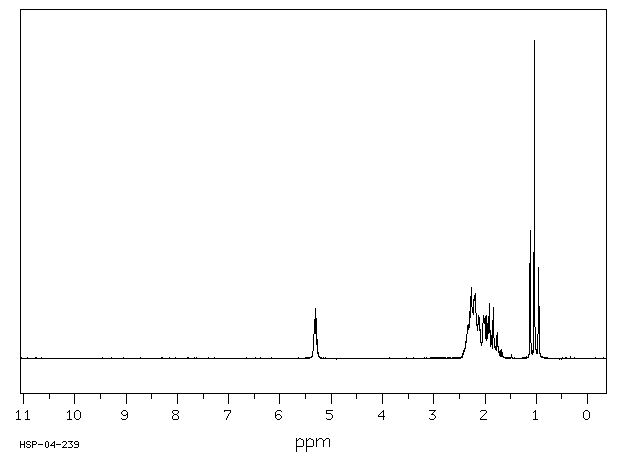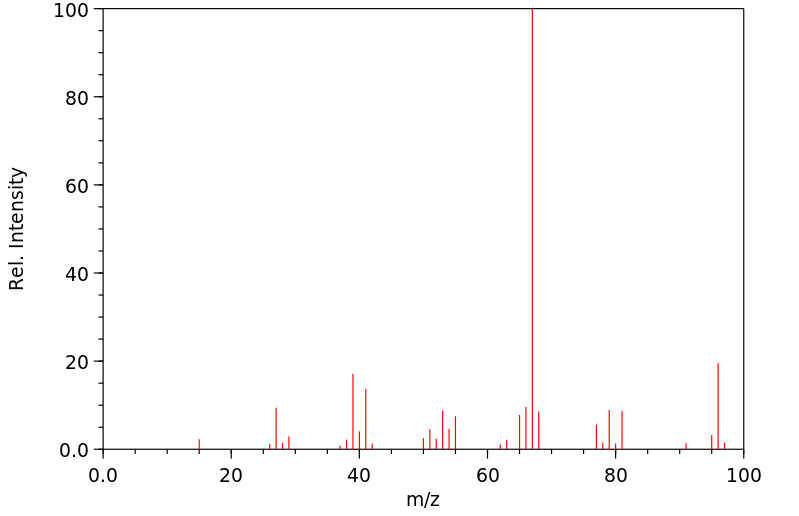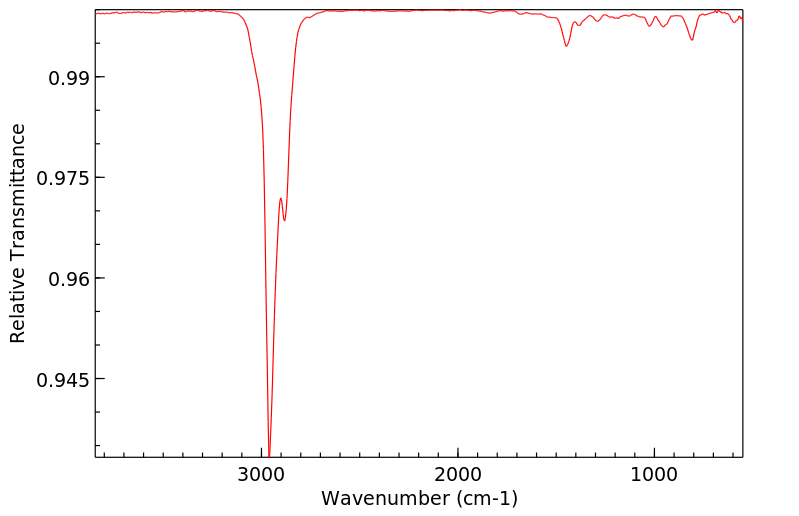1-乙基-1-环戊烯 | 2146-38-5
-
物化性质
-
计算性质
-
ADMET
-
安全信息
-
SDS
-
制备方法与用途
-
上下游信息
-
文献信息
-
表征谱图
-
同类化合物
-
相关功能分类
-
相关结构分类
物化性质
-
熔点:-118.4°C
-
沸点:107 °C
-
密度:0.80
-
保留指数:751;751;750;753;752;755
计算性质
-
辛醇/水分配系数(LogP):2.3
-
重原子数:7
-
可旋转键数:1
-
环数:1.0
-
sp3杂化的碳原子比例:0.714
-
拓扑面积:0
-
氢给体数:0
-
氢受体数:0
安全信息
-
危险等级:3
-
海关编码:2902199090
-
危险品运输编号:UN 3295
-
储存条件:一、贮存:请将物品置于室温下保存,避免阳光直射和高温环境。建议存放在通风良好且干燥的地方,并确保容器密封。
SDS
模块 1. 化学品
产品名称: 1-Ethyl-1-cyclopeNTene
修改号码: 5
模块 2. 危险性概述
GHS分类
物理性危害
易燃液体 第2级
健康危害 未分类
环境危害 未分类
GHS标签元素
图标或危害标志
信号词 危险
危险描述 高度易燃液体和蒸气
防范说明
[预防] 远离热源/火花/明火/热表面。禁烟。
保持容器密闭。
使用防爆的电气/通风/照明设备。采取预防措施以防静电和火花引起的着火。
穿戴防护手套/护目镜/防护面具。
[急救措施] 皮肤接触:立即去除/脱掉所有被污染的衣物。用水清洗皮肤/淋浴。
[储存] 存放于通风良好处。保持凉爽。
[废弃处置] 根据当地政府规定把物品/容器交与工业废弃处理机构。
模块 3. 成分/组成信息
单一物质/混和物 单一物质
化学名(中文名): 1-乙基-1-环戊烯
百分比: >96.0%(GC)
CAS编码: 2146-38-5
分子式: C7H12
1-乙基-1-环戊烯 修改号码:5
模块 4. 急救措施
吸入: 将受害者移到新鲜空气处,保持呼吸通畅,休息。若感不适请求医/就诊。
皮肤接触: 立即去除/脱掉所有被污染的衣物。用水清洗皮肤/淋浴。
若皮肤刺激或发生皮疹:求医/就诊。
眼睛接触: 用水小心清洗几分钟。如果方便,易操作,摘除隐形眼镜。继续清洗。
如果眼睛刺激:求医/就诊。
食入: 若感不适,求医/就诊。漱口。
紧急救助者的防护: 救援者需要穿戴个人防护用品,比如橡胶手套和气密性护目镜。
模块 5. 消防措施
合适的灭火剂: 干粉,泡沫,二氧化碳
不适用的灭火剂: 水(有可能扩大灾情。)
特定方法: 从上风处灭火,根据周围环境选择合适的灭火方法。
非相关人员应该撤离至安全地方。
周围一旦着火:喷水,保持容器冷却。如果安全,消除一切火源。
消防员的特殊防护用具: 灭火时,一定要穿戴个人防护用品。
模块 6. 泄漏应急处理
个人防护措施,防护用具, 使用个人防护用品。远离溢出物/泄露处并处在上风处。确保足够通风。
紧急措施: 泄露区应该用安全带等圈起来,控制非相关人员进入。
环保措施: 防止进入下水道。
控制和清洗的方法和材料: 回收到密闭容器前用干砂或惰性吸收剂吸收泄漏物。一旦大量泄漏,筑堤控制。附着
物或收集物应该根据相关法律法规废弃处置。
副危险性的防护措施 移除所有火源。一旦发生火灾应该准备灭火器。使用防火花工具和防爆设备。
模块 7. 操作处置与储存
处理
技术措施: 在通风良好处进行处理。穿戴合适的防护用具。防止烟雾产生。远离热源/火花/明火
/热表面。禁烟。采取措施防止静电积累。使用防爆设备。处理后彻底清洗双手和脸。
注意事项: 如果可能,使用封闭系统。如果蒸气或浮质产生,使用通风、局部排气。
操作处置注意事项: 避免接触皮肤、眼睛和衣物。
贮存
储存条件: 保持容器密闭。存放于凉爽、阴暗、通风良好处。
远离不相容的材料比如氧化剂存放。
包装材料: 依据法律。
模块 8. 接触控制和个体防护
工程控制: 尽可能安装封闭体系或局部排风系统。同时安装淋浴器和洗眼器。
个人防护用品
呼吸系统防护: 防毒面具。依据当地和政府法规。
手部防护: 防护手套。
眼睛防护: 安全防护镜。如果情况需要,佩戴面具。
皮肤和身体防护: 防护服。如果情况需要,穿戴防护靴。
模块 9. 理化特性
液体
外形(20°C):
外观: 透明
颜色: 无色-几乎无色
气味: 无资料
pH: 无数据资料
1-乙基-1-环戊烯 修改号码:5
模块 9. 理化特性
熔点: 无资料
沸点/沸程 107 °C
闪点: 无资料
爆炸特性
爆炸下限: 无资料
爆炸上限: 无资料
密度: 0.80
溶解度:
[水] 无资料
[其他溶剂] 无资料
模块 10. 稳定性和反应性
化学稳定性: 一般情况下稳定。
危险反应的可能性: 未报道特殊反应性。
避免接触的条件: 火花, 明火, 静电
须避免接触的物质 氧化剂
危险的分解产物: 一氧化碳, 二氧化碳
模块 11. 毒理学信息
急性毒性: 无资料
对皮肤腐蚀或刺激: 无资料
对眼睛严重损害或刺激: 无资料
生殖细胞变异原性: 无资料
致癌性:
IARC = 无资料
NTP = 无资料
生殖毒性: 无资料
模块 12. 生态学信息
生态毒性:
鱼类: 无资料
甲壳类: 无资料
藻类: 无资料
残留性 / 降解性: 无资料
潜在生物累积 (BCF): 无资料
土壤中移动性
log水分配系数: 无资料
土壤吸收系数 (Koc): 无资料
亨利定律 无资料
constaNT(PaM3/mol):
模块 13. 废弃处置
如果可能,回收处理。请咨询当地管理部门。建议在装有后燃和洗涤装置的化学焚烧炉中焚烧,焚烧时需要特别注
意该物质是高度可燃的。废弃处置时请遵守国家、地区和当地的所有法规。
模块 14. 运输信息
联合国分类: 第3类 易燃液体 。
UN编号: 3295
正式运输名称: 碳氢化合物, 液体, 不另作详细说明
1-乙基-1-环戊烯 修改号码:5
模块 14. 运输信息
包装等级: II
模块 15. 法规信息
《危险化学品安全管理条例》(2002年1月26日国务院发布,2011年2月16日修订): 针对危险化学品的安全使用、
生产、储存、运输、装卸等方面均作了相应的规定。
模块16 - 其他信息
N/A
上下游信息
-
上游原料
中文名称 英文名称 CAS号 化学式 分子量 3-甲基-1-环己烯 1-Methylcyclohexene 591-49-1 C7H12 96.1723 -
下游产品
中文名称 英文名称 CAS号 化学式 分子量 亚乙基环戊烷 ethylidenecyclopentane 2146-37-4 C7H12 96.1723
反应信息
-
作为反应物:描述:参考文献:名称:通过一锅顺序缩醛化,Tishchenko反应和by离子和硫醇的协同催化内酯化作用,从5-氧代烷醛立体选择性合成δ-内酯。摘要:通过sa离子和硫醇的协同催化,一系列5-氧代烷醛以有效和立体选择性的方式转化为(取代的)δ-内酯。这一一锅法包括一系列缩醛化,Tishchenko反应和内酯化。与醇相比,有意使用硫醇有利于促进催化循环。提出了反应机理和立体化学,并得到了一些实验证据的支持。sa离子/硫醇共催化反应显示出远程控制的特征,适用于旋光性δ-内酯的不对称合成。这项研究还证明了两种昆虫信息素(2S,5R)-2-甲基己内酯和(R)-十六烷内酯的合成,DOI:10.1021/jo016058t
-
作为产物:描述:参考文献:名称:转氨酶触发的氮杂-迈克尔方法用于哌啶支架的对映选择性合成摘要:不断扩大的生物催化剂“工具箱”为重新设计靶向分子的合成策略开辟了新的机会,通过将关键的酶促步骤纳入合成。在此,我们描述了一种通用的生物催化方法,用于从容易获得的前手性酮烯酮开始对映选择性制备 2,6-二取代哌啶。该策略代表了一种新的生物催化断开,它依赖于 ω-TA 介导的 aza-Michael 反应。重要的是,我们表明可逆的酶促过程可以推动胺官能团在分子框架中的穿梭,从而提供获得所需的 aza-Michael 产品的途径。DOI:10.1021/jacs.6b07024
-
作为试剂:描述:1-乙基-1-环戊烯 、 碳酸氢钠 、 、 7-amino-1-methyl-1,3-dihydro-2H-benzimidazol-2-one 、 氢气 在 钯 1-乙基-1-环戊烯 、 acetone hexanes 作用下, 以 甲醇 为溶剂, 反应 12.0h, 以to afford 597 mg (75%) of the title compound的产率得到7-(2-ethyl-1-piperidinyl)-1-methyl-1,3-dihydro-2H-benzimidazol-2-one参考文献:名称:Nitrogen-containing fused heterocyclic compounds摘要:提供了一种CRF受体拮抗剂,包括式(I)的化合物:其中,环A是由式(A')表示的5元环:其中X是碳,X1是氧、硫或—NR5—,或由式(A'')表示的环:其中X是氮,R6是可选取代的烃基,R1是氨基,由两个可选取代的烃基基团取代,R2是苯基,Y1是CR3a或氮,y2是CR3b或氮,Y3是CR3c或氮,但Y1、Y2和Y3中至多一个是氮,W是键,—(CH2)n—,Z是键,—NR4—等;或其盐或前药。公开号:US20070135452A1
文献信息
-
Manganese (III) based oxidative free-radical annulations作者:Barry B. Snider、Brad O. BuckmanDOI:10.1016/s0040-4020(01)89163-8日期:——of diethyl allylmalonate (6b), sterically nucleophilic alkenes, Mn(OAc)3·2H2O and Cu(OAc)2·H2O gives methylenecyclopentanes 13 to 17 in 17–100% yield by an oxidative free-radical annulation. Similarly, oxidative annulation of diethyl crotylmalonate and ethyl benzylacetoacetate with an alkene gives vinylcyclopentane (30) and tetralin (35).
-
Optical Probes inside Photonic Crystals作者:W.L. Vos、A. PolmanDOI:10.1557/mrs2001.160日期:2001.8
The spontaneous emission of an atom is not a property of the atom only; it also depends on the local optical surroundings. The simplest demonstration of this effect was provided by the early experiments of Drexhage, who studied the emission rate of luminescent europium ions close to a mirror. It was found that while the spectral distribution of the emission remained constant, the emission rate was dependent on the position of the Eu3+ ions relative to the mirror. This effect is due to interference of the optical modes incident to and reflected at the mirror. Since then, the modified spontaneous emission of atoms in cavities has been studied extensively. More recently, the control of spontaneous emission in solid-state systems has become of great interest because it enables the tailoring of the emission properties of optical materials. It was shown how the spontaneous-emission rate of optical probe ions or dyes inside dielectric films is modified by the presence of a dielectric interface, in a dielectric multilayer, or a microcavity. The dependence of the decay rate on the optical surroundings in these one-dimensional systems can be described in terms of Fermi's “golden rule,” which states that the decay rate is proportional to the local optical density of states (DOS). The spatial variation in the DOS is due to the interference of optical modes reflected and refracted at the dielectric interface(s).
原子的自发辐射并不仅仅是原子本身的属性;它还依赖于局部的光环境。这种效应最简单的演示是由Drexhage的早期实验提供的,他研究了发光的铕离子在镜子附近的发射率。研究发现,虽然发射的光谱分布保持不变,但发射率却依赖于铕离子相对于镜子的位置。这种效应是由于入射到镜子上并从镜子反射的光学模式的干涉造成的。自那时起,人们广泛研究了腔中原子修改后的自发辐射。最近,控制固态系统中的自发辐射已经引起了极大的兴趣,因为它能够定制光学材料的发射特性。已经展示了光学探针离子或染料在介电膜内的自发发射率如何通过介电界面、介电多层膜或微腔的存在而发生变化。这些一维系统中衰减率对光学环境依赖性可以用费米“黄金规则”来描述,该规则指出衰减率与局部光学态密度(DOS)成正比。DOS的空间变化是由于在介电界面反射和折射的光学模式的干涉造成的。 -
Intrinsic migration aptitudes of alkyl groups in a pinacol rearrangement作者:Eckehardt Wistuba、Christoph RüchardtDOI:10.1016/s0040-4039(01)82067-0日期:1981.1From rates of solvolysis of substituted cis-2-tosyloxy-cyclopentanols in sodium acetate buffered acetic acid the following relative migration aptitudes were deduced: H(171); CH3(6.7); C2H5(9.7); 2-C3H5(5.2); t-C4H9(2.5); C6H5(62).
-
Fluorinated compound, fluoropolymer and method for producing the compound申请人:Asahi Glass Company, Limited公开号:US07825275B2公开(公告)日:2010-11-02To provide a novel fluorinated compound, a fluoropolymer and a method for producing the compound. A compound represented by the formula CF2═CFCF2C(X)(C(O)OZ)(CH2)nCR═CHR (wherein X is a hydrogen atom, a cyano group or a group represented by the formula —C(O)OZ, Z is a hydrogen atom or a C1-20 monovalent organic group, n is 0, 1, or 2, and R is a hydrogen atom or a C1-20 monovalent organic group), a method for producing it, and a fluoropolymer obtained by polymerizing the compound.
-
Deuterium isotope effects for migrating and nonmigrating groups in the solvolysis of neopentyl-type esters作者:V. J. Shiner、Jimmy J. TaiDOI:10.1021/ja00392a031日期:1981.1-deuterium rate effects on the solvolysis of (1-methylcyclohexyl)methyl, (1-methylcyclopentyl)methyl, and (1-methylcyclobutyl)methyl sulfonate esters have been measured and the solvolysis products examined by /sup 2/H NMR spectroscopy. The results indicate that the products of the solvolysis of all these sulfonate esters are predominantly (greater than or equal to 98%) rearranged. In the solvolysis of (1-m..cap α..- 和 ..gamma..- 氘速率对(1-甲基环己基)甲基、(1-甲基环戊基)甲基和(1-甲基环丁基)甲基磺酸酯的溶剂分解的影响已被测量,并且溶剂分解通过/sup 2/H NMR光谱检查产物。结果表明,所有这些磺酸酯的溶剂解产物主要(大于或等于 98%)重排。在(1-甲基环己基)甲基三氟甲磺酸酯的溶剂分解中,甲基迁移的重排产物略高于扩环产物。对于甲基-d/sub 3/ 化合物观察到正常同位素效应,在 80E 中为 1.057,在 97T 中为 1.073,并且在 80E 中观察到亚甲基-d/sub 4/ 化合物的反向效应为 0.963。然而,在(1-甲基环戊基)甲基和(1-甲基环丁基)甲基磺酸盐的溶剂分解中,主要产品为扩环产品。在这些例子中,对甲基-d/sub 3/-标记的物种观察到了相反的影响。在(1-甲基环己基)甲基的溶剂分解中,观察到的同位素效应可以分为0.927、0
表征谱图
-
氢谱1HNMR
-
质谱MS
-
碳谱13CNMR
-
红外IR
-
拉曼Raman
-
峰位数据
-
峰位匹配
-
表征信息










